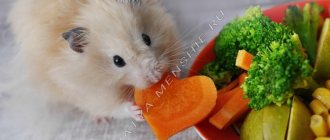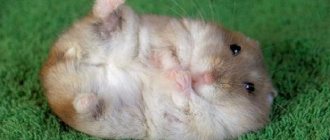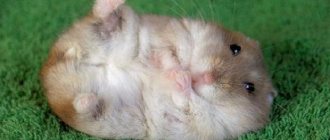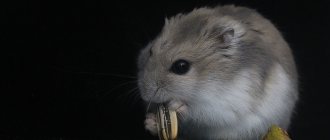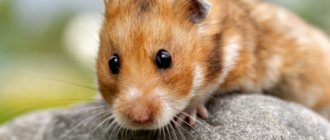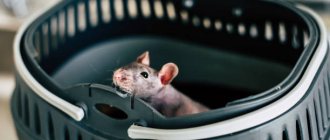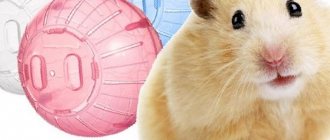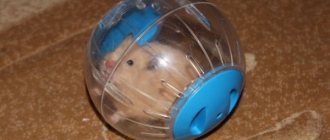A caring owner is always concerned about improving the living conditions of his pet. An important aspect of caring for a hamster is feeding. Inexperienced rodent owners are interested in how many times a day to feed a hamster so that the pet feels cheerful, stays healthy and cheerful.
Proper, nutritious nutrition is an important element that contributes to the longevity of an animal. Diet is as important as the foods that make up the animal’s diet. Read more about the list of prohibited and permitted products to avoid health problems for your pet.
Hamsters are most active at night. During the day, rodents prefer to sleep or rest. When thinking about how often to feed a hamster, you should take into account the rhythm of the animal’s life.
Basic rules for keeping Djungarian hamsters
When composing a diet for animals, you should focus on their natural nutritional needs. Life in steppe conditions adapted them to low-calorie food. Nutritious, fatty, it will cause damage to the digestive system: the Djungarian hamster is prone to obesity, and sweets are the cause of the development of diabetes. In a confined space, when the animal does not have the opportunity to move a lot, the diet of the Djungarian hamster should be prepared correctly, preventing the appearance of excess weight. A dzhungarik needs only a tablespoon of food per day. The activity of the rodent is increased by frequent walks, outdoor games, and, of course, the wheel on which the animals love to run.
Read also: Test: Which hair color suits me?
Wild individuals feed on seeds and grain. Collecting supplies in a hole, they seal themselves in it, feeding on dry foods during the cold period. In spring and summer, the diet is more varied: berries, fruits, vegetables, herbs, insects, and smaller animals are used. The Djungarian hamster's teeth grow throughout its life, so it is necessary to give them the opportunity to grind them down.
The Djungarian hamster's teeth grow throughout its life, so it is necessary to give them the opportunity to grind them down.
The metabolism of the little glutton is fast, hamsters eat constantly. The Djungarian hamster should not be allowed to starve, as this will cause its health to deteriorate. But obesity will not bring anything good to the hamster.
Syrian hamster: description
The Syrian hamster is the result of crossings of various species, and quite rare, wild hamsters. This animal was accidentally discovered at one time in Syria. Adult individuals are characterized by medium size.
Adult specimens grow to a maximum length of 13.5 cm, while their tail is only one and a half centimeters long. The maximum weight of adults is about 250 grams, with females being slightly larger than males. Despite this, Syrian hamsters have a short but strong body.
The animal's coat consists of soft and fairly thick fur, which is painted in golden tones. The characteristic habitats of these animals in nature are the areas adjacent to the city of Aleppo, as well as the eastern territories of Turkey.
Interesting fact! The front paws of this animal have four toes, and the hind paws are armed with five toes.
The muzzle is characterized by the presence of rounded shapes, and as for the ears, they are small, as is the tail, which is barely noticeable due to the rather thick coat. There are both long-haired and short-haired species.
How long do Syrian hamsters live?
As far as we know, regardless of their habitat, be it the natural environment or being in captivity, hamsters live no more than 3 years.
Under certain conditions, by providing the animal with balanced feed, you can extend the life of your pet, although only slightly.
Product table: what Djungarian hamsters can and cannot eat
| You can give | Can't give | With caution or in small quantities |
| GRAINS | ||
| Oats | Pasta | Rice |
| Corn | Bakery products | Buckwheat |
| Wheat | Legumes: (peas, beans) | Lentils |
| Barley | ||
| Rye | ||
| SEEDS AND NUTS | ||
| Sunflower | Brazilian nut | |
| Pumpkin | Almond | |
| Linen | Pine nuts | |
| Cashew | Cherry, apricot pits | |
| Sesame | Acorns | |
| Walnut | Chestnuts | |
| Hazelnut | ||
| Peanut | ||
| VEGETABLES | ||
| Eggplant | Watermelon | Cucumber |
| Broccoli | Melon | Tomato |
| Zucchini | Potato | Radish |
| Carrot | Cabbage | Celery |
| Radish | Onion | Asparagus |
| Turnip | Garlic | Cauliflower |
| Beetroot (not sugar) | ||
| Pumpkin | ||
| Jerusalem artichoke | ||
| FRUITS | ||
| Apple | Persimmon | Apricot, plum |
| Pear | Citruses (orange, grapefruit, lemon) | Peach, nectarine |
| Banana | Exotic fruits (pineapple, kiwi, mango) | |
| BERRIES | ||
| Barberry | Honeysuckle | Grape |
| Hawthorn | Elder | |
| Cowberry | ||
| Pitted cherry | ||
| Strawberries and wild strawberries | ||
| Raspberries | ||
| Sea buckthorn | ||
| Rowan | ||
| Currant | ||
| Rose hip | ||
| GREENS, HERBS | ||
| Tops of carrots, beets | Sorrel | Parsley |
| Any salad (iceberg, corn) | Conifer branches | Dill |
| Clover | ||
| Nettle | ||
| Dandelions | ||
| Plantain | ||
| Leaves and branches of fruit trees (apricot, cherry, apple), other deciduous trees (birch, rowan, alder). | ||
| PROTEIN PRODUCTS | ||
| Cottage cheese 1% | Sausage | Boiled white fish |
| Low-fat white yogurt | Raw meat or fish | Peeled boiled shrimp |
| Boiled egg (chicken/quail) | Milk | Gammarus, daphnia |
| Boiled lean meat: beef, rabbit, turkey, chicken (breast). | Cheese | |
| Mushrooms |
List of recommended products
Experienced breeders argue about the benefits of some products, but there is a basic list of food necessary for a hamster.
Vegetables
Vegetables in a rodent's diet include:
- cucumbers;
- pumpkin;
- bell pepper;
- carrot;
- zucchini;
- tomatoes;
- eggplant;
- broccoli.
Among vegetables, cucumbers are included in the diet.
Fruits
Fruits are important for the normal functioning of your pet's digestive system due to their high fiber content. It is best to give a banana, pear, apple. You can try treating your pet to peaches and plums, but be careful.
Exotic fruits often contain substances that are dangerous to the hamster. They are excluded from the diet.
Berries
Berries should not be sour. You can feed your pet:
- strawberries;
- strawberries;
- lingonberries;
- rowan;
- currants;
- rosehip;
- blueberries;
- cherries and pitted cherries.
You can feed your pet strawberries.
Grapes are given carefully and little by little.
Greenery
Rodents eat a lot of greens, so you need to include in their daily diet:
- nettle;
- plantain;
- dandelions;
- alfalfa;
- basil;
- carrot and beet tops;
- lettuce leaves;
- dill and parsley in small quantities.
Before feeding, the collected herbs should be washed and dried. Greens picked within city limits contain toxins that are dangerous to the hamster. Fresh grass can be dried for the winter.
Animal protein for the carnivorous dwarf
Rodents eat insects and snails, so they need animal protein. Pets are fed meat cooked without salt and spices. Pork, beef, turkey, chicken and lean fish are suitable for hamsters. Boiled chicken or quail eggs are given 2 times a week.
Rodents eat boiled chicken eggs.
Insects need to be purchased at a pet store, because earthworms and butterflies caught within the city can be toxic to a hamster.
Cereals
Cereals are the basis of the diet of rodents. Special foods include:
- corn;
- barley;
- rye;
- oats;
- wheat.
When collecting cereals yourself, you need to check whether they are infected with a fungus, since ergot is a common disease of cereals. If ingested, it can cause paralysis and lead to death. The collected grain must be dried, as moisture promotes the appearance of fungus.
Buckwheat, peas, lentils and chickpeas are suitable for hamsters. Beans are heavy food for an animal's weak stomach.
Milk
It is not recommended to feed hamsters dairy products as they are too fatty for them. During pregnancy and feeding the cubs, the female can be given low-fat cottage cheese or 1% yogurt in small portions.
During pregnancy, the female can be given low-fat cottage cheese.
Nuts
Djungarian hamsters are fed:
- peanuts;
- walnuts;
- cashew nuts;
- hazelnuts
Almonds should not be given; they are poisonous to small animals because they contain hydrocyanic acid.
Seeds
For a hamster, seeds are a treat that, due to their fat content, should be given no more than 2 times a week, 5-6 pieces. Recommended treats for your pet:
- pumpkin;
- linen;
- squash;
- sesame;
- and sunflower seeds.
It is recommended to treat your pet with pumpkin seeds.
Dried fruits
Hamsters can be given dried fruits, but they need to be introduced into the diet gradually. The feed includes: dried apricots, figs, dates, dried bananas, apples and pears. Raisins, like grapes, should be given carefully.
Bakery products
Flour products (pasta, baked goods, etc.) are contraindicated for rodents, as they cause bloating, which can lead to the death of the animal. Rye bread is an exception; in small quantities it does not cause digestive problems.
Rye bread can be eaten in small quantities.
Features of feeding
Having decided what you can feed Djungarian hamsters, it is important to create the right schedule in order to get a varied and balanced menu for your pet. The main feature of nutrition is a competent combination of permitted foods. A hamster's diet should not be monotonous, but 80% of it consists of ready-made food from a mixture of cereals.
It is necessary that your pet receive dry, protein and juicy food every day; these three components of the menu are the main part of the regular diet. In no case is it allowed to arrange a day for a dzhungarik only with vegetables or only with protein in the diet.
Important! Djungarians, like all hamsters, are distinguished by their desire to store food. In this regard, it is not recommended to give them treats in large quantities, since hidden food will quickly deteriorate and rot.
Additional feeding to the main dry food is carried out according to the following schedule:
- protein foods (meat and eggs) – no more than once a week;
- greens - every other day, preferably dried;
- fruits and allowed berries – once every 2 weeks;
- nuts and raw seeds should be given as treats not too often and in moderation;
- vegetables, especially white and green, 2-3 times a week.
When feeding jungarians with vegetables and fruits, preference should be given to seasonal products, since only then will they benefit the animal’s body. It is advisable to peel apples and pears. All products for the Djungarian hamster must be fresh and well washed.
Kinds
As a result of selection, Djungarian hamsters with different colors and types of coat were bred. The most common colors:
- Standard color. The back is gray-brown, with a dark stripe that runs from the head and tail. The belly and paws are white or light gray.
- Pearl color. This is a white Djungarian hamster . There is often a dark stripe on the back, although the color may be solid. With age, hamsters are able to change the brightness of their color: lighten or, on the contrary, become darker.
- Mandarin. The body is orange, with a dark brown stripe on the back.
Previously, the Campbell's hamster was considered one of the varieties of Djungarian hamsters. It turned out that these are still different species that are capable of producing hybrids. The Djungarian hamster in the photo is practically no different from Campbell. The only differences are in the structure of the fur: the Campbellbell hamster’s fur is disheveled and sticks out in different directions, while the Djungarian hamster’s fur is soft and smooth.
What kind of apples can you give?
Hamsters can eat apples and even need them, but on the condition that the fruits are fresh:
- will be ripe;
- not treated with chemicals and various growth stimulants;
- before offering such food to a rodent, it must be thoroughly rinsed under running water;
- It is recommended to soak fruits purchased at the supermarket in water for several hours to neutralize the effects of pesticides.
Offer your pet apples of sweet and sour varieties. They are more useful and do not have a negative effect on the animal’s gastric mucosa. Can hamsters have sweet apples? Fruits with a high content of sucrose are harmful for such a pet. They can provoke the development of diabetes and related diseases.
You can give hamsters apples, but only after they reach one month of age. At an earlier age, eating this fruit can cause diarrhea, vomiting and gastrointestinal upset.
When offering this product to your furry, do not forget that it contains seeds. Fruit pits are contraindicated for hamsters because they contain a toxic substance - hydrocyanic acid. Therefore, before giving them to the animal, cut them in half and remove the entire core of the fruit.
Both Syrians and Dzungarians can eat apples. Almost all breeds of the Hamyakov family can eat this delicacy with great pleasure.
Read also: mint and green IN COLOR BALANCE
Dried apples
Many livestock breeders are interested in whether hamsters can eat dried apples? Of course you can! The hamster will be happy to eat such a treat. The main thing is that the drying is prepared correctly, and always without adding sugar and salt. In dried form, such a product does not lose its valuable properties and qualities. Dried apples normalize metabolic processes and prevent the development of gastrointestinal diseases.
Baked and stewed apples
As for baked and stewed apples, it is not recommended to give them to your pet. This product is of little use to your pet hamster. In addition, it can cause discomfort and pain in the stomach and intestines. As a result, your hamster may experience vomiting, nausea, and diarrhea.
How to choose vitamins
Buy medications in pet stores and veterinary pharmacies. Vitamins exist in solid and liquid form - in tablets and syrup. If your hamster does not agree to chew hard pellets, you can grind them into powder and add them to food. Give liquid, one drop at a time, into food or water. If their cost is important to you, then solid vitamins are cheaper. Experiment with which ones are more suitable for your pet, but not in the dose and frequency of administration. It will only do harm.
Sometimes pharmacies offer drops for hamsters. This is a treat for them. They contain pieces of dried fruits and berries, which are high in calories. Whether to buy them or not is the choice of the animal owner. But they will not replace vitamins, since they simply are not included. And if the rodent quickly gains weight, their number also needs to be reduced.
Interesting Facts
Djungarian hamsters were domesticated only in the middle of the twentieth century. Rodents of this breed feel comfortable in an apartment and get along well with people.
A few facts will help you better understand these animals:
- Rodents' teeth grow throughout their lives, so they need mineral stones to grind them down. Too large incisors can damage the animal's delicate cheeks.
- Rodents of this breed do not hibernate in winter, but in severe frosts they become numb for several hours. This condition may mean that the animal is stressed or lacking oxygen.
- At temperatures below +16°C, hamsters shed. In winter, their gray color becomes lighter.
- They are capable of traveling several tens of kilometers during the night. In the wild, hamsters divide territory and, if invaded, fiercely defend their home, so it is not worth putting 2 animals in a cage. They do well alone.
- Pregnancy in these rodents lasts for 25 days. From 1 to 11 cubs are born.
- The Djungarian hamster is a dwarf breed, individuals reach 10 cm in length and weigh from 30 to 65 g. The animals are distinguished by smooth fur and a dark stripe along the body, which most individuals have.
- Rodents of this breed quickly get used to humans, but taming should be gradual.
Reproduction
Djungarian hamsters become sexually mature at four weeks of age. It is during this period that children of different sexes must be separated from each other. Early pregnancy is very dangerous for the female. Placing her with a male “so as not to get bored” is not the best idea. Constant pregnancies will quickly kill the female. It is almost impossible to sell cubs at a high price. Therefore, there is no point in risking the health of the animal.
Read also: How to spell change correctly?
The female is mated with the male at the age of 4 months. This age is considered optimal for the first pregnancy. After mating, the female and male should be seated, otherwise they can harm each other. Pregnancy lasts about 25 days. 1-11 babies are born. They are completely defenseless and dependent on their mother. Often, for some unknown reason, females abandon their babies or even eat them.
Only healthy adults with known pedigree should be bred. Due to the great external similarity of Djungarian hamsters to Campbell's hamsters, hybrid offspring are born quite often. Since Campbell's hamsters are prone to diabetes, they are able to pass this trait on to their offspring. That is why it is important to breed only purebred Djungarians.
What else can Djungarian hamsters eat?
- Fruits (not exotic, but “local”) - eat no more than a couple of times a week, preferably 1.
- If your dry food does not contain greens, you can add them to the diet (dried).
- Non-starchy vegetables (cucumber, bell pepper) - can be eaten almost every day, alternating.
- Low-starch vegetables (zucchini, carrots, pumpkin) - it is enough to feed them to the dwarf 2 times a week.
- Protein – 1-2 times a week.
- Nuts, seeds - try to give them less often, as a treat (high fat content of the product).
The main emphasis in nutrition is on grains.
What fruits and berries can hamsters eat?
Fruits for the Djungarian hamster should not be too sweet (remember about diabetes!). It is for this reason that you should not feed the dzhungarik exotic foods at all. Occasionally, you can give a dried banana, but not more than once a week (formally, a banana is a berry, but that’s what we’re used to).
Be sure to remove large seeds and pits from the fruit. Many of them can be poisonous to the dwarf. The possibility that such a baby will simply choke on the seeds cannot be ruled out either.
Follow the same recommendations when choosing berries.
Lifehack. Use glycemic index tables for foods. Those with a high indicator should never be fed to the Djungarian hamster.
A few words about dried fruits. These are the same fruits, only the water has been removed from them. The composition remains virtually unchanged; we feed according to the same principles as fresh fruit.
Choose fruits that are as sweet as possible for your pet.
What vegetables can dzungaria eat?
Vegetables have the same problem - they increase the risk of diabetes. Here we are no longer talking about sweets (fructose), but about starch, which “works” in the same way as fructose or sugar - it increases the level of glucose in the blood.
Therefore, try to feed your hamster vegetables that are low in starch and high in fiber.
The less starch in vegetables, the better.
What do hamsters prefer from greens?
For greens, let's eat your usual salad, parsley and dill (1-2 times a week). From “improvised” (more precisely, pasture) plants, you can feed plantains and dandelions. Greens are a storehouse of vitamins, microelements and nutrients for the Djungarian rodent, do not neglect them.
Avoid greens that have a strong smell or taste. Those. any plants that have an imbalance in composition (too many essential oils or acids). That is why it is strictly forbidden to feed the Djungarian hamster with onion sprouts, garlic and sorrel.
Don't forget about greens - very healthy.
Animal protein for the carnivorous dwarf
In its natural environment, the dzhungarik is by no means a vegetarian, and is not averse to sometimes eating what passes by. These are mainly insects. Therefore, for proper nutrition, you need to add protein foods to your hamster’s menu.
Ideal for:
- Boiled egg whites
- Skim cheese
- Boiled white fish
- Lean boiled meat of other animals (beef, chicken, turkey)
You can feed protein once a week (pregnant and lactating females, babies - more often, but we have a separate conversation about this).
I'm a predator!!! Strong!!! But easy...
Amount of food
How much a hamster eats per day depends on several factors:
- Age of the pet – youngsters eat more than adults.
- Pregnancy, feeding babies.
- Ambient temperature.
- Rodent activity.
According to statistics, a hamster eats a volume of food per day equal to 70% of its body weight. For example, a Syrian weighing about 150 g should be fed 100 g of food.
As a rule, owners do not make accurate calculations, guided by observations of the pet. Don't feed your Djungarian hamster too much. Overfeeding will lead to obesity and health problems.
It’s funny to look at a fluffy, plump dwarf, but the animal is very uncomfortable with excess weight. Obesity threatens serious diseases and shortens the life of a hamster. Keep an eye on your pet while eating; he may not eat the amount of food intended for him, but may hide some of it.
How to feed the dzhungarik correctly?
Djungarians are cute and funny hamsters that are not at all difficult to keep at home. In most cases, it is enough to purchase a cage, fill it with the necessary toys and accessories, and also provide the fluffy with regular and high-quality food. What kind of diet will be healthy and complete for a hamster?
If you do not adhere to certain nutritional rules, the animal may get sick, which often leads to a sad end. The mistake of many Djungarian pet owners is that they let their pets try absolutely everything from their table.
And hamsters eat everything that is offered. This is strictly forbidden. If the owner of a hamster does not want to shorten the animal’s already short life span, then you should familiarize yourself with the basic rules of nutrition and a healthy diet.
Favorite treats
One of the main activities of a hamster is eating everything. Accordingly, if you want to pamper your animal, prepare him something tasty. I would like to warn you right away that many people offer recipes for treats containing cabbage, milk and cheese. But these products are included in the list of prohibited foods, so such delicacies will only harm the jungaric. So, what treat can you prepare for your Djungarian hamster at home?
Fruity
You will need fruits, various seeds, nuts and one teaspoon of honey and one grape. It is worth remembering that all food must be served without seeds. Also remove the peel from the fruit.
Combine honey with fruit pulp and roll in chopped nuts.
Banana
For this delicacy you will need oatmeal, raisins, nuts and, of course, bananas.
First you need to mash the banana, then add raisins. Then we form balls from the prepared mixture and roll them in chopped nuts and oatmeal.
Honey cookies
To make honey cookies you will need one teaspoon of honey, two tablespoons of muesli, one oatmeal cookie and 3 sunflower seeds, chopped carrots or cucumber.
The cooking process itself is extremely simple. Oatmeal cookies should be coated with honey. Then muesli is placed on top of the honey. We cover all this with crushed seeds and vegetables.
Djungarians are susceptible to diabetes, so you should not abuse this sweetness.
Cereal cookies
To make grain cookies you will need any cereal, chopped nuts, protein and seeds.
First of all, you need to mix all the dry ingredients, then pour the whipped egg white over everything. We form cookies from the resulting mass and place in the oven at a temperature of 60 degrees. You can also add protein to the grain mixture.
It is important to remember that hamsters are used to eating raw food, so you shouldn’t pamper them with cookies often.
The Dzhungarik is a rather whimsical animal, so some food is not recommended for consumption, and some can kill the hamster.
What to feed a Djungarian hamster at home
When kept at home, the hamster's diet is designed so that it matches the natural diet. Do not think that Djungarian hamsters are strict vegetarians. Under natural conditions, they eat not only grains, seeds, fresh grass, berries, but also enjoy jumping insects (grasshoppers, crickets), beetle larvae, and earthworms. Therefore, in addition to grain mixtures, juicy vegetables and herbs, the hamster needs foods high in protein. Research which food categories are allowed for hamsters.
What diseases require vitamins?
- In spring or autumn, like a person, a hamster may need additional supplements for general vitamin deficiency.
- Feeding is also needed for pregnant and lactating females.
- Sometimes the animal begins to lose its fur. There can be many reasons for this condition. But one of them is an excess or lack of vitamins. To determine the cause of baldness, the veterinarian must take a scraping from the skin and examine the animal’s skin under a special lamp. Only after this can a specialist prescribe vitamins for hamsters against baldness or advise them to adjust the diet in some other way. Let us repeat once again that without examining the rodent by a specialist, it is impossible to add vitamin complexes to your pet’s diet. It’s better to offer your pet fresh vegetables, fruits or herbs, all of which contain a huge amount of essential vitamins for hamsters.
Did you like the article? Share with friends: [supsystic-social-sharing >
- Related Posts
- How long do hamsters sleep?
- Hamster allergy, symptoms, causes
- Hamster or rat, which one should you prefer?
Choosing dry food
Instead of self-composed grain mixtures, you should prefer ready-made industrial food produced under brands specializing in food for rodents. Their composition includes the amount of nutrients, mineral and vitamin supplements necessary to maintain the health of the hamster. In addition to the traditional components of dry food, the composition of some immediately includes dried vegetables, dried fruits and other elements of a balanced diet.
For your pet, you need to purchase high-quality food produced by trusted companies. If possible, you should avoid cheap feeds that are classified as economy-class products. It is best to buy food intended specifically for Djungarian hamsters, since mixtures for other varieties may contain prohibited components that will have to be pre-selected manually.
Dry food takes up 80-90% of a hamster's daily diet. At the same time, the daily food requirement for a fluffy is one tablespoon. Despite all the gluttony of a rodent, its proper, complete feeding does not require large expenses.
Amount of food
How much food a hamster needs per day depends on many factors:
- physical activity;
- age (young animals eat much more);
- physiological state (pregnancy, lactation);
- room temperature.
The average rodent eats an amount of food per day equal to 70% of its body weight.
A Syrian hamster weighing 140-150 g should receive about 100 g.
Such accuracy of calculations is not used in practice, and the owner can only approximately say how much a hamster eats per day.
The Djungarian hamster or Campbell is so small that it seems to the owners that they are eating “closely.”
It is a big mistake to overfeed your pet. Hamsters get fat easily.
From the outside it may look cute, but the animal itself faces serious health problems and shortens its life. If a dwarf has already received a tablespoon of dry food, and the feeder is instantly empty, you should not fill it again. The pet simply hid food around the cage.
What to feed a pregnant and lactating female Djungarian hamster?
Pregnant and lactating females and juveniles require a diet high in protein. On average, proteins should make up 12-15% of his total diet. The amount of feed should be increased by about 1/3. If this is not done, then the female may begin to kill part of her offspring and eat it, since she needs protein to raise the rest.
The nutrition of juveniles is similar to that of adult animals, except that they should be given protein food more often; the female will take care of the smallest ones.
The Syrian is a cheerful, smart hamster
The Syrian hamster or Syrian is the largest rodent among domestic hamsters, but this does not prevent him from seeming like a cute and funny animal. The rodent achieved its popularity because caring for it does not require large amounts of money and is quite easy.
These animals are clean and therefore have no unpleasant odor. At night, the Syrian can make noise, since it is still a nocturnal animal. But this small drawback is fully compensated by the excellent mood that the Syrian gives to its owner.
The hair of the Syrian hamster has a yellow color and for this it is also called golden. Although there are representatives of the species and other colors. Depending on the length of their fur, Syrian hamsters come in short-haired and long-haired varieties.
The length of the rodent's body is 12-19 centimeters, and its weight is about 100-200 grams. Females are much larger than males. The animal's body is stocky, its muzzle and legs are short, its ears are rounded, and its eyes look like two small black beads. The front and rear paws have a different number of toes: the hind paws have four, and the front paws have five.
Prohibited foods can be deadly
Risk of poisoning
Poisoning is extremely dangerous for dzungarians. If poison enters the body, death can occur within a few hours. If poisoning occurs gradually, the animal may suffer for up to several days. The most common cause of poisoning is:
- poisonous seeds that got into grain feed;
- spoilage of the mixture by pests, the presence of mold, pathogenic bacteria in it;
- ingestion of poisonous plants;
- chemicals in greens;
- rot in vegetables, fruits;
- improper storage of feed.
Cause constipation
If the amount of droppings has decreased, it has become dry and hard, the hamster’s tummy is swollen, the pet is restless, and may be constipated. Its cause is most often a disruption of the intestines, insufficient consumption of fiber and moisture in the body. Trauma, stress, and pathological conditions can also provoke this state.
Constipation can be caused by:
- quince,
- pear,
- rice,
- legumes,
- canned meat.
Causes diarrhea
The cause of diarrhea in Djungarians is most often an infection, but a similar reaction to certain foods is also possible.
- citrus,
- onion,
- garlic,
- beet,
- almond.
In addition, diarrhea can be caused by a sudden change in diet, the introduction of a new product, spoiled food, or overeating. Sometimes foreign objects (small buttons, beads) enter the body while walking around the house. In this case, it is important to immediately consult a veterinarian.
Cause fermentation
For a small animal, fermentation in the gastrointestinal tract is a serious problem that leads to a significant deterioration in health. You should avoid introducing the following foods into your animal’s diet:
- potatoes,
- legumes,
- cabbage,
- sour berries
- black bread,
- sweets,
- flour products.
Legumes in general can be present in limited quantities in the diet of the dwarf, provided that the body of a particular individual is able to digest them normally.
Too fat
Hamsters are cute creatures that most owners (and more often their guests) have a regular desire to pamper. Moreover, products are chosen that seem especially tasty to the person himself. This is exactly what happens with baked goods, a variety of salty crackers, chips, puff pastries, and cheeses. Due to their high fat content, such products should not be included in the diet. Guests should be warned about this immediately to avoid troubles with the pet’s health.
Cheek pouches hurt
Some products are not dangerous, but can cause problems due to the tiny size of the dwarf and its habits. The sharp edges or hard texture of the product may cause sores on the inside of the cheek pouches. It is for these reasons that you should not give your hamster dry pasta or seeds with sharp edges (it is better to clean them).
Allergy risk
Most often, allergic reactions occur to fruits, berries, and vegetables with bright colors. You may develop a similar intolerance to certain foods due to too frequent consumption. Signs of problems may include the appearance of redness on the skin, the animal's constant desire to scratch, and watery eyes. Most often, allergies occur to strawberries, cheeses, and exotic fruits.
Feed with caution
The following foods are not healthy for your hamster. However, they are not mortally dangerous, which means that they are given to the animal in very limited quantities:
List of relatively dangerous products:
- rice;
- buckwheat;
- lentils;
- cucumber;
- tomato;
- radish;
- asparagus;
- celery;
- cauliflower;
- apricot;
- plum;
- nectarine;
- peach;
- grape;
- parsley;
- dill;
- boiled shrimp;
- boiled white fish;
- daphnia;
- gammarus.
Rules for feeding permitted products
The diet of Djungarian hamsters should be varied: the same foods should not be given day after day (except for dry food). It is optimal if the hamster receives dry, juicy and protein food every day. You cannot have a “vegetable” or “meat” day.
Djungarians love to stock up, so it is not recommended to give treats in large pieces: the product will deteriorate and rot if buried in the house. Inventory audits are carried out regularly. A piece of 1 cm in size will be optimal for a dwarf hamster.
How often can you feed your dwarf with additions to dry food?
- fruits and berries – once every 2 weeks;
- greens - every other day, preferably dried;
- vegetables - white or green every day (zucchini, Jerusalem artichoke, cucumber, turnip) others (pumpkin, carrots) - 2 times a week;
- nuts and seeds – rarely, as a delicacy;
- meat, eggs - once a week.
The recommendations do not take into account special needs: for example, a pregnant female can eat protein foods 2-3 times a week.
All products must be fresh and of high quality.
When feeding vegetables and fruits, preference is given to seasonal products. All succulent food is not only washed thoroughly, but they try to get rid of the “chemical” component (nitrates, pesticides). The greens are soaked, the apple is peeled.
In winter, you can’t help but think about what to feed the dzhungarik: overseas tasteless tomatoes and it’s scary to eat yourself. A good alternative to greenhouse vegetables would be oat, wheat, sunflower sprouts, and greens frozen from the summer.
Diet composition
Here's what Djungarian hamsters eat at home:
- grain mixture (dry food);
- succulent food (greens, grass, fruits, vegetables, berries);
- protein feed (dietary meat, eggs, insects);
- vitamin supplements;
- mineral stone, branches of fruit trees.
The basis of nutrition is industrial food for dwarf hamsters, a mixture of grain crops and freely available fresh drinking water. On such a diet, a hamster can live for a very long time, even without additional treats.
It is important to observe the measure: fruits should not make up more than 5% of the dzhungarik’s diet , even allowed ones are given in a piece no more than 1 cm. Vegetables are given every other day, and berries - no more than once a week.
Any new product is introduced into the diet in a tiny portion, with caution. also need to change dry food to a mixture from another manufacturer gradually , over the course of a week, to avoid digestive upset.
Another option
Experts and those who breed hamsters advise not to get carried away with vitamins. Even if you buy domestic food for your animal, the best option for it is not a vitamin complex, but a pack of imported food. It should be mixed with domestic one, and as a result you will have a mixture with all the necessary vitamins. It will cost you less.
So decide for yourself which option to use. Observe your pet and draw conclusions about what will be best for him - be guided by this.
Please rate the article
4.1730769230769 Rating 4.17 (26 votes)
